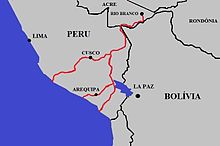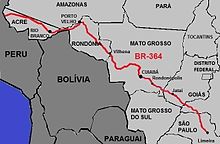Transoceánica

Transoceánica or Carretera Transoceánica ( German : transozeanische Landstraße ) is the name of a connecting road between the Atlantic and the Pacific on South American soil. The road leads in Brazil from São Paulo via Cuiabá , Porto Velho , Rio Branco , Puerto Maldonado to Cusco and from here on to the Peruvian ports of San Juan de Marcona , Arequipa and Ilo .
Mainly this road was built for economic reasons. It is intended to enable trade between Peru and Brazil and to facilitate the export of raw materials from the Amazon region, especially soy , to the Asian markets via the Latin American Pacific ports. On the other hand, it is said that the Transoceánica is an important step for the international community UNASUR . Accordingly, the integration of Peru and Brazil is to be promoted.
Critics see several of the most biodiverse forest areas on earth and the isolated indigenous peoples living there endangered by the road in the border area with Peru, especially on the Peruvian side.
Since January 2016, the world's longest bus line has been operating on the Transoceánica between São Paulo and Lima, at 6,200 kilometers; a journey between the two cities takes 102 hours. It is carried out by the Peruvian bus company Expreso Internacional Ormeño SA .
See also
- South American transcontinental railway (planned railway connection Bioceánica between Ilo in Peru and the port city of Santos near São Paulo in Brazil, possibly via Bolivia )
- Transamazônica
Individual evidence
- ↑ Wolfgang Kunath: A trunk road threatens the Indians. In: Frankfurter Rundschau. June 14, 2008, accessed March 17, 2009 .
- ↑ Longest bus route in the world started. In: The world . January 31, 2016, accessed July 28, 2019 .
- ↑ Expreso Internacional Ormeño - Destinations (Spanish). Retrieved July 28, 2019 .

